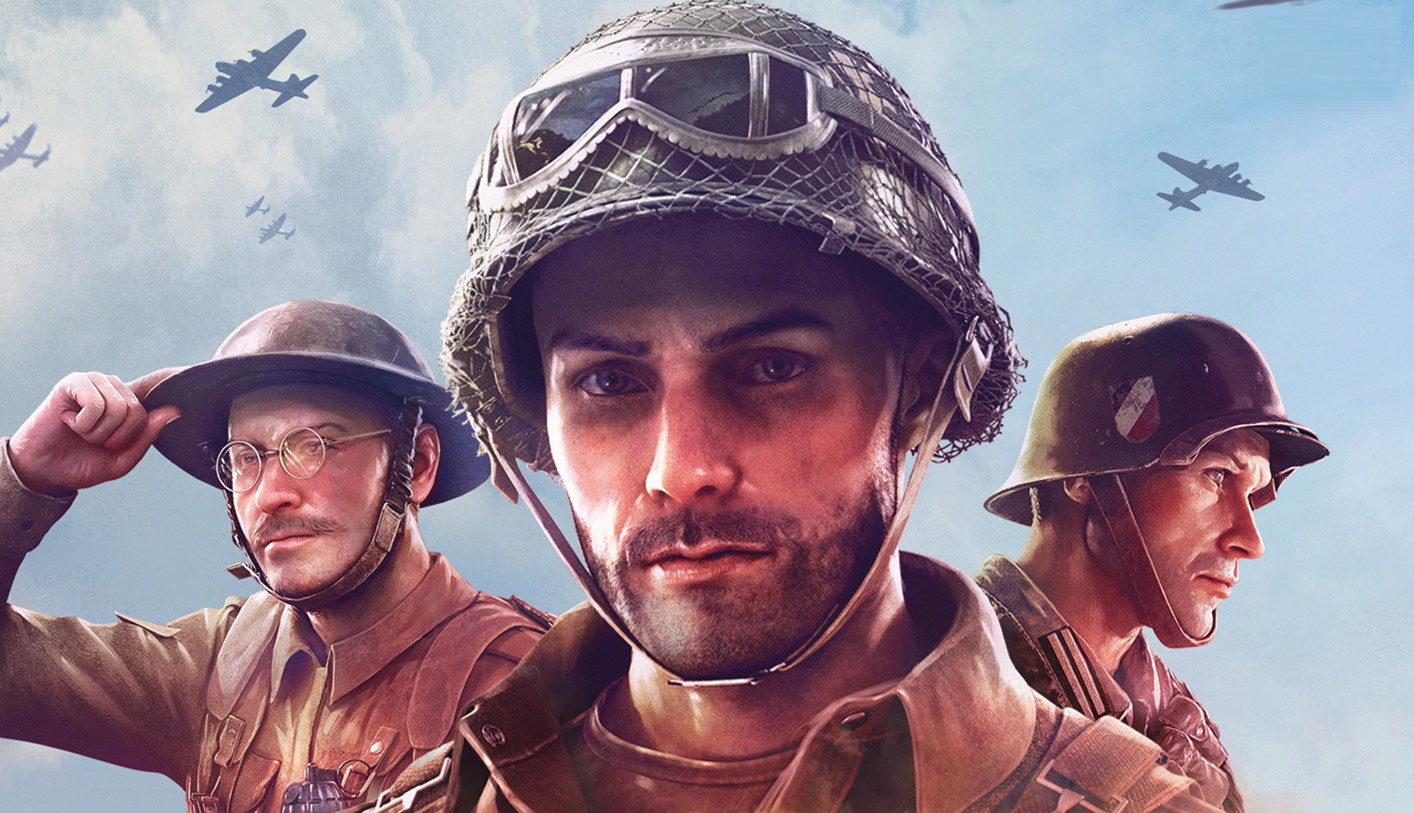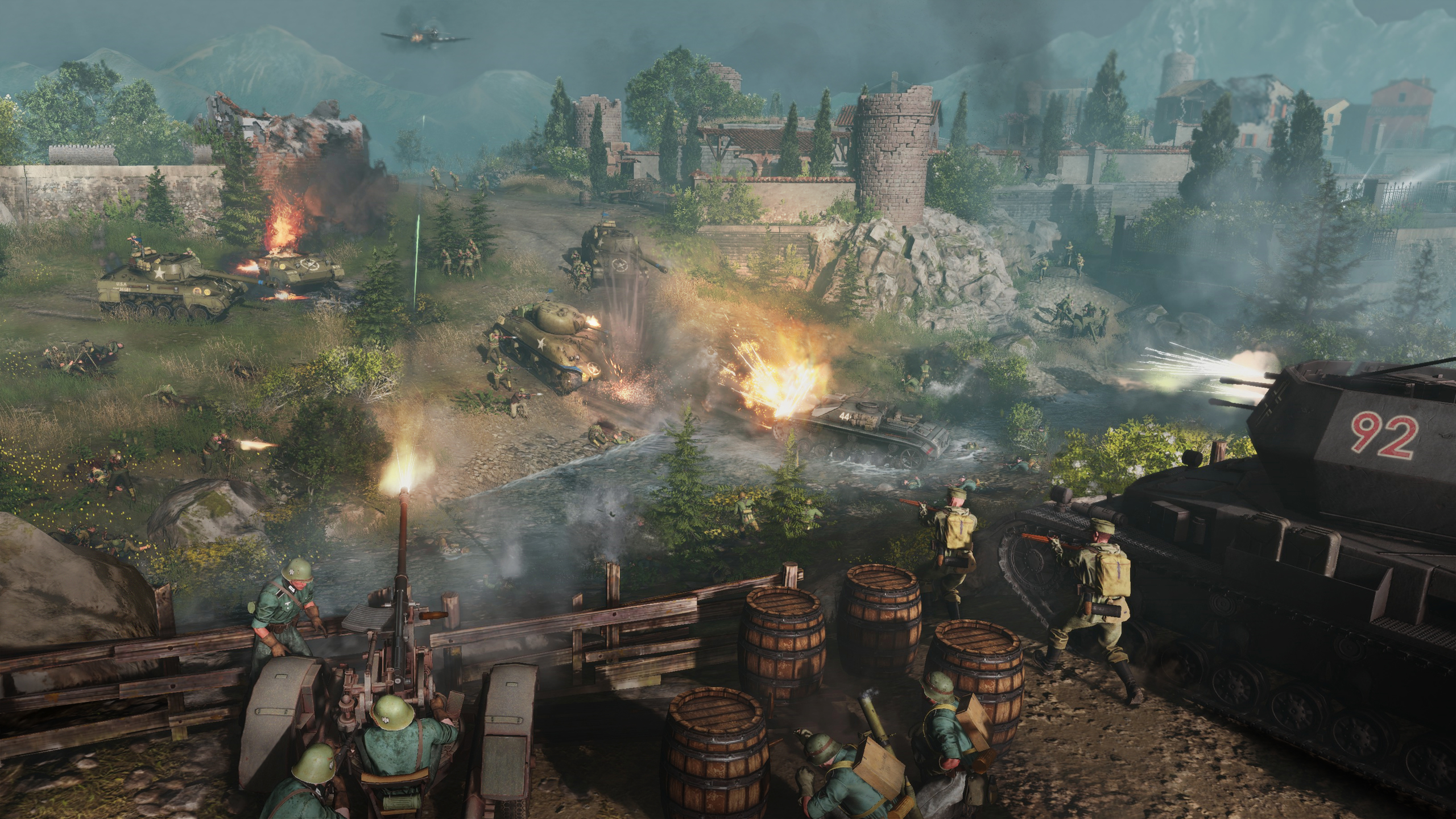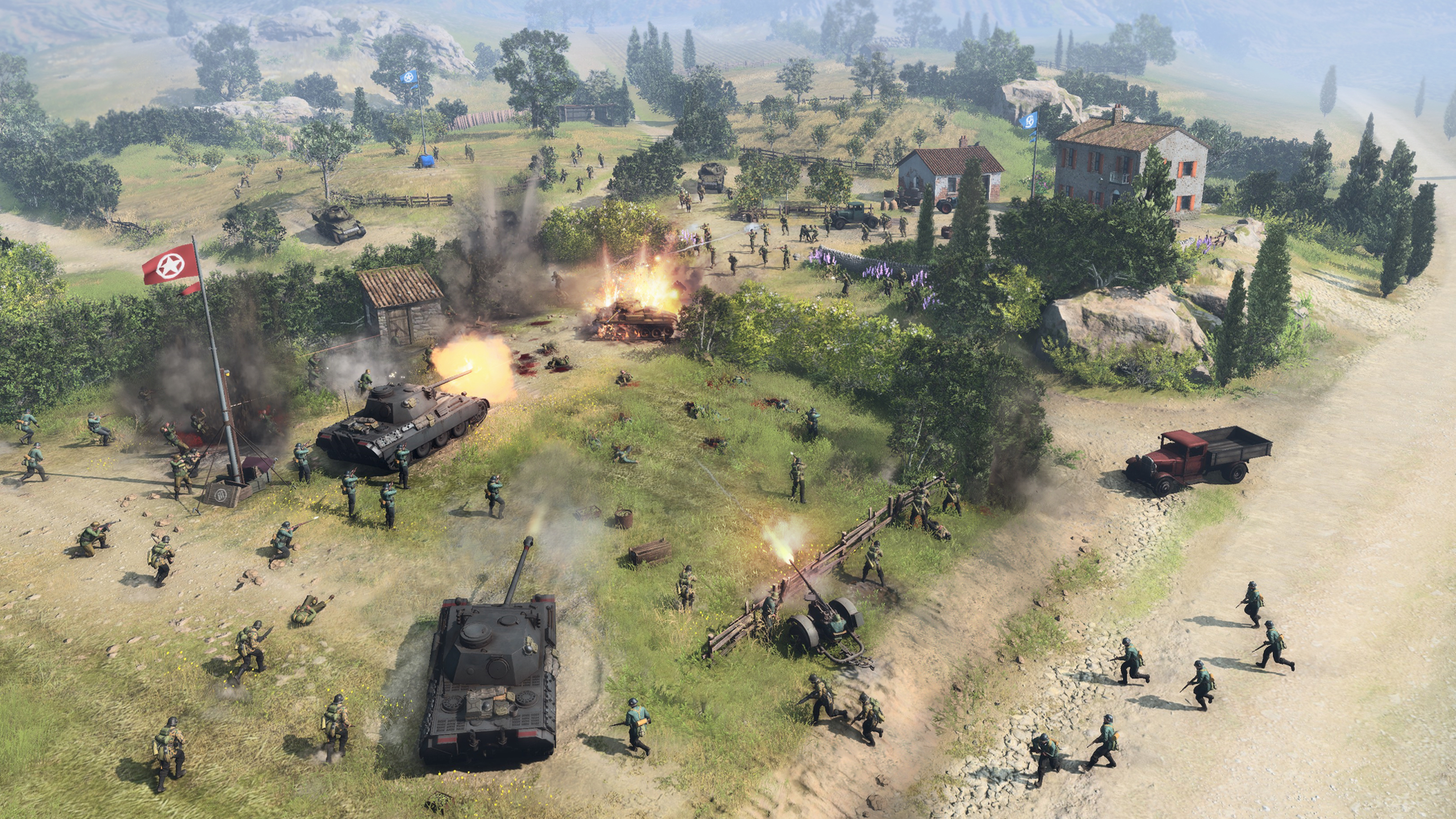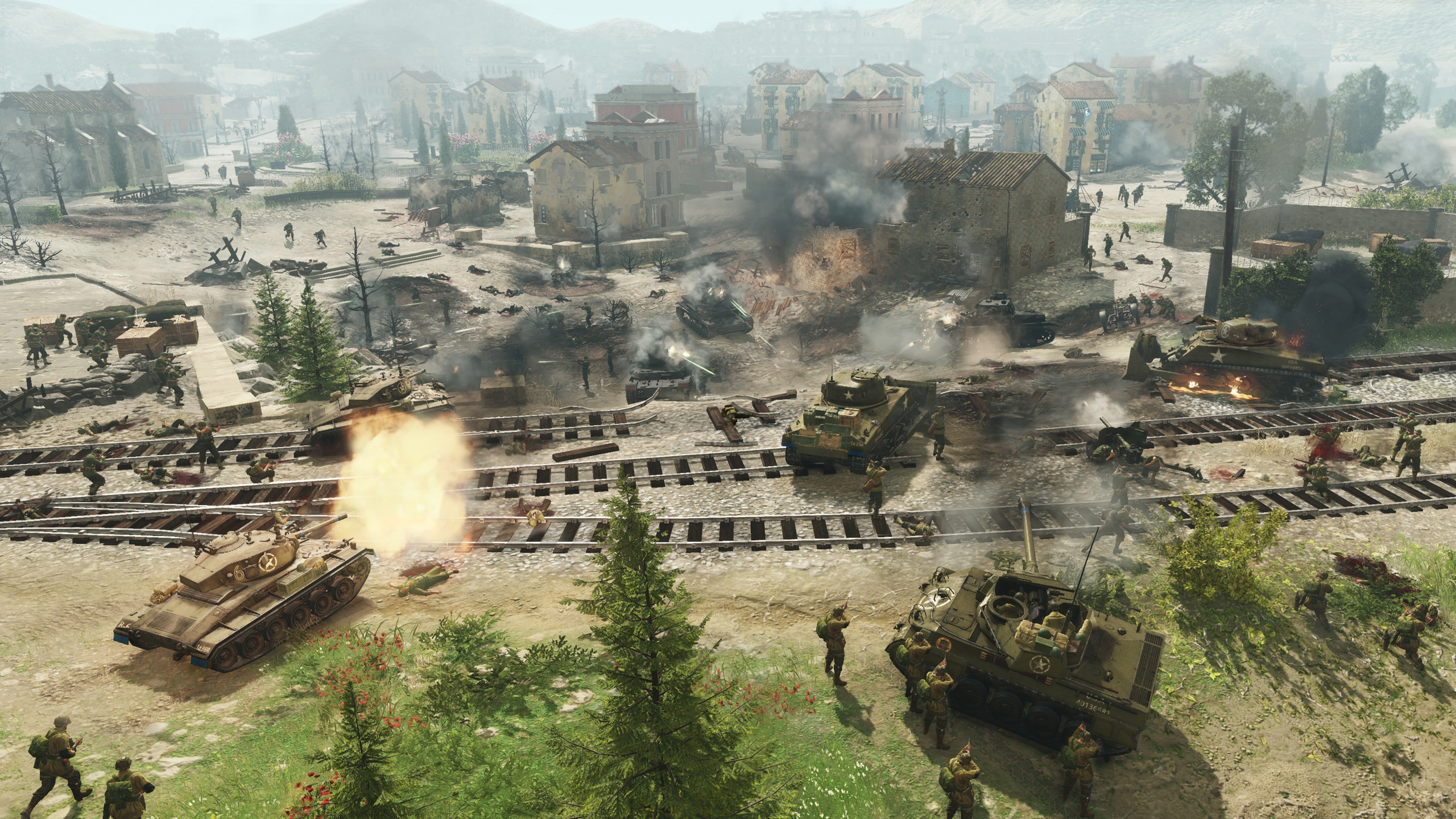How Relic built Company of Heroes 3's multiplayer with its community
The player council, Discord and forums have proved to be crucial.

Ahead of Company of Heroes 3's bombastic multiplayer coming to Steam in the form of a week-long pre-alpha demo—which kicked off yesterday—I caught up with Relic to find out what's changed since its predecessor, and how the studio leveraged its community, from competitive players to map designers, to create what it hopes will be its beefiest multiplayer experience so far.
There are some significant additions to the Company of Heroes formula this time, not least of which is the huge dynamic singleplayer campaign, but despite this Company of Heroes 3 is more iterative than revolutionary—yes, there's plenty that's new, but it's all building on familiar foundations, following a vision for a World War 2 RTS that Relic has nurtured over the last 15 years.
At the centre of this vision is the concept that every battle tells a story. "This came from Quinn Duffy, our original design director on Company Heroes 2," lead gameplay designer Matt Philip recalls. "This is a nice way of encapsulating the series. And I think when it comes to Company of Heroes 3, we're returning to this exact phrase, that every battle does tell a story, but we want to just tell a richer, deeper story that's more vibrant. We've got a brand new theatre, as you know, and we're hoping to tie in both narrative gameplay and all these other things, all these elements, to craft a larger, deeper story."
It's a marketing slogan, sure, but that doesn't make it any less true. The greatest test of this ideal is probably the multiplayer, where it doesn't have a discrete story or named characters with a hint of agency—that's all in the campaign. But from my experiences so far, AI skirmishes and competitive multiplayer are just as deft at storytelling as campaign battles. Just read my Company of Heroes 3 multiplayer hands-on preview and you'll see how it can't help but spawn emergent narratives.
One of the ways Company of Heroes tells stories, or at least encourages them to emerge, is through the veterancy system. If you keep your troops alive, you'll get to see them grow into more powerful, specialised units—if you lose them, that matters a lot more. For Company of Heroes 3, Relic's kept veterancy, but expanded it into multiple systems, which work differently depending on the faction you pick. The pre-alpha build contains two factions, the US forces and the German Wehrmacht.
Executive producer David Littman told me that even the setting itself, the Italian campaign, was partly down to the player council
"The veterancy systems are very new," senior designer Will Ward explains. "They will follow the same kind of guidelines that we had previously in the franchise, but they're both very unique, very new, in terms of what they bring to the table. The US forces have two different options per unit as to how you would like them to receive veterancy. Whereas the Wehrmacht units will instead receive veterancy based on what Field Marshal they take. They have a choice of three Field Marshals, and that can govern an overriding theme throughout the entire faction. So these are returning systems that we wanted to give a new lease of life when we possibly can."
Relic already knew players wanted more of that, but to find out what the rest of their expectations were, the studio invited a group of players to join it in Vancouver, forming a player council. This was back in 2017, before development had properly commenced, and since then the group has grown, informing plenty of crucial decisions. Earlier this year, executive producer David Littman told me that even the setting itself, the Italian campaign, was partly down to the player council. And they've had just as big an impact on the multiplayer. Some members of the player council have even joined the development team.
The biggest gaming news, reviews and hardware deals
Keep up to date with the most important stories and the best deals, as picked by the PC Gamer team.

Ward, for instance, started out as a fan and modder, designing maps for Company of Heroes 2. "This closed community was made up of competitive gamers, content creators and people like myself, who would create maps and Steam Workshop content for Company of Heroes 1 and 2," he says. "It was essentially a roundtable discussion on where we wanted the franchise to go, any ideas that we had and really what we thought the next instalment could be."
Ward recalls an exercise where members of the council designed their own American faction, and some of these ideas ended up being carried through to the actual game. Relic had already started designing the faction, Philip adds, but had hit a speedbump and was looking for fresh perspectives. "We were like, this is going to be a challenging army to design, because we looked at the tools we had available to us, and we were like 'Wait a second, we've used 90% of what we've done in the two previous games, so what are we going to do?' So we wanted to see what they'd come up with." And you can see the results of that now in one of the USF starting units: the scout squad.
The player council members all wanted to see a dedicated scout unit, and that desire ended up influencing what's become a key unit in the faction's roster. Scouting and recon in general have also been given a lot more attention this time around. There's a proper recon system now, which allows recon units to get a little bit more information about what's lurking behind the fog of war—just enough so that you can prepare a little bit, without giving you all the information. Eugen Systems' RTSs, like Steel Division and Ruse, served as inspiration for this feature, and Relic's been paying close attention to its games, and Creative Assembly's Total War, to see what can be drawn from them.
With these dedicated, seemingly hardcore players having so much influence, I was wondering where that left players who prefer an AI comp stomp or just mucking around in co-op with some friends—the less competitive, more casual players. Philip says that this was a consideration straight away, however, back when players were first invited to give feedback and throw ideas at Relic. And Ward himself is a good example of this.

"Because I was a mapmaker and a modder, I am very much a casual player," he says. "I'll be playtesting the vast majority of my maps alone, and if I did ever play with other people, it would usually be with friends versus AI—that's just the way I like to play. And even though you can definitely see that there might be more of the competitive players' voices heard, it doesn't mean that there isn't feedback coming in from a casual audience. I think having so many means of contacting us, not just in the closed group, but through the Discord as well as through the forums, we're getting a lot of voices from a lot of directions."
The player council members all wanted to see a dedicated scout unit, and that desire ended up influencing what's become a key unit in the faction's roster
You can't talk about multiplayer games without talking about balance. It's an obsession for some players, who maybe worry about it a bit too much. Naturally, it's been a topic that Relic's discussed internally a great deal. "We love talking about balance," says Philip, without a hint of sarcasm.
"There's a little bit of a misconception from our community that we balance, for example, for just a particular mode," he says. "They'll often say, 'Oh, you only balance for 1v1, and that's it.' But the first thing we do is we take a big step back, and whatever the change, whether it's a design change, a balance change or any change that we're doing across the board to the product, we always try to [see it from the point of view] of the whole audience. We've got hyper-competitive players, we've got casual players, we've got omnivores—or hybrid players—we've got [solo players], we've got comp stompers, the whole lot. So whenever we make a single change, let's say there's this scout, and it has this ability, OK, is this ability going to be useful in singleplayer? Is it going to be useful in multiplayer? Is it going to be useful in 1v1 and 4v4? And we try to make sure that we look at all those lights across the entire board of a product, for just holistic design."

Relic doesn't have rules about balance etched in stone. It takes on feedback from the player council, has developers focused on balance experiments, and tinkers away. Sometimes that's going to mean a nerf, sometimes that's going to mean a buff, and there are occasions where fun and empowerment trump traditional balance. One example is unit call-ins, where you can summon special units onto the battlefield. Competitive players have criticised the system because they see these units as unearned rewards that you're not teching to receive. But Philip's perspective is that it's a lot of fun to have these cool tools that you can deploy without going through the teching motions. It's a competitive game, but it's still a game.
The studio's balance philosophy also seems more additive than subtractive. Take vehicle recovery, for instance. This feature allows specific vehicles—there's one in the USF Armored battlegroup in the pre-alpha—to find and recover wrecks, spending some resources to make it fighting fit again. This includes enemy vehicles, allowing smart players to fill in any gaps in their battlegroup with units they wouldn't normally be able to field. It's a powerful ability. To make this more balanced, Relic's toying with the resource cost, so it's not something you can keep doing over and over again without a strong economy. It's considering counterplays, too, and maybe making the recovery vehicle vulnerable while it's fixing up the wreck. The ability remains powerful, then, but it creates wrinkles and even new opportunities to the opposing team. In balancing it, Relic makes it even more interesting.
Balancing will continue long after Company of Heroes 3 launches, of course, and Relic's naturally looking well into the future. It's not spilling the beans on its post-launch plans just yet, but you can at least expect things like support for community creations and custom maps. Philip isn't sure if it will be in there on day one, but "definitely afterwards". And maybe these new map designers will one day end up at Relic, like Ward, designing official maps for the next installment.
To check out the multiplayer pre-alpha and see the changes Relic's made, you can sign up for the 'CoH-development' programme for free, netting you access to this and all future demos.

Fraser is the UK online editor and has actually met The Internet in person. With over a decade of experience, he's been around the block a few times, serving as a freelancer, news editor and prolific reviewer. Strategy games have been a 30-year-long obsession, from tiny RTSs to sprawling political sims, and he never turns down the chance to rave about Total War or Crusader Kings. He's also been known to set up shop in the latest MMO and likes to wind down with an endlessly deep, systemic RPG. These days, when he's not editing, he can usually be found writing features that are 1,000 words too long or talking about his dog.

